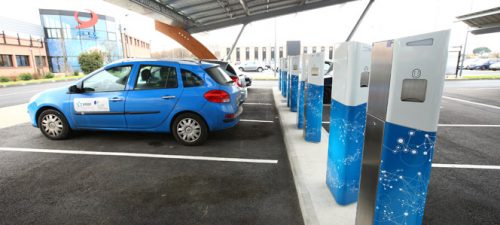As their costs fall, five power technologies are swelling into “energy tsunamis” that threaten to sink oil prices to $10 a barrel within a decade.
Thierry Lepercq, executive VP for research, technologies, and innovation at French utility giant Engie SA, warns the oil industry must brace itself against five energy tsunamis: solar power, battery storage, electric vehicles, “smart” buildings, and cheap hydrogen.
 More charging stations for electric vehicles is helping to grow one of the ‘energy tsunamis.’
More charging stations for electric vehicles is helping to grow one of the ‘energy tsunamis.’
Image: Engie electric car charging stations in Rotterdam, the Netherlands.
In an interview reported by Bloomberg, Lepercq says:
“Even if oil demand continues to climb until 2025, its price could drop to $10 if markets anticipate a significant fall in demand.”
J curve
Lepercq says solar power and battery storage technology, along with hydrogen-powered and electric vehicles are on a “J curve” and they are inter-related.
In a J curve there is an initial drop in demand but then it takes off to reach a level that is higher and more sustained.
Lepercq implies the technologies combine to help each other along the J curve. He says in the interview:
“Hydrogen is the missing link in a 100 percent renewable-energy system, but technological bricks already exist.”
Engie is undergoing a transformation of its that is also helping to swell the energy tsunamis. It is moving away from coal and gas as dominant assets toward renewables and services.
The $73 billion group is planning to spend $1.6 billion over the next 2 years acquiring new technologies. These include: grid-scale battery storage, mini-grids for powering small groups of homes, hydrogen output, and smart buildings that save energy and money by linking heating, lighting, and IT systems.
Mini-grids helping rural Africa bypass fossil fuels
One of Engie’s objectives is to provide rural populations with access to environmentally-friendly electricity. For instance, in 2015, the group launched a project that has installed a mini-grid in the village of Ketumbeine in Tanzania.
Consisting of photovoltaic (PV) solar units with a 16 kW peak (kWp) capacity, a 45 KWh lithium-ion battery bank and a back-up generator, the mini-grid provides clean energy to 161 homes that previously relied on kerosene lamps, car batteries and power generators.
The plan is to roll out more mini-grids across Africa. With 620 million Africans still without electricity, the move appears to be an example of what president Francois Hollande of France meant when he said developing countries could leapfrog western nations by skipping fossil fuels and going straight to renewable energy.
Lepercq says the idea is to develop “technology platforms in which massive value can be created from comparatively small investment.”
Hydrogen and electric vehicles
Another new area of application for the company is the use of hydrogen to power vehicles. To this end it joined Michelin and bought a stake in Symbio FCell, a French fuel cell company that developed the first range extender for hybrid (combined electricity and hydrogen) vehicles.
According to the International Energy Agency, the number of electric cars in use worldwide reached 1.26 million at the end of 2015.
The two main markets for electric vehicles are China and the United States. The IEA predict that individual country commitments would bring 13 million electric cars on the road by 2020.
Lepercq says we will see a progressive shift as more electric cars come on the market that can travel over 500 km on one charge, more charging stations are made available, and more cities ban vehicles that use gasoline and diesel.
